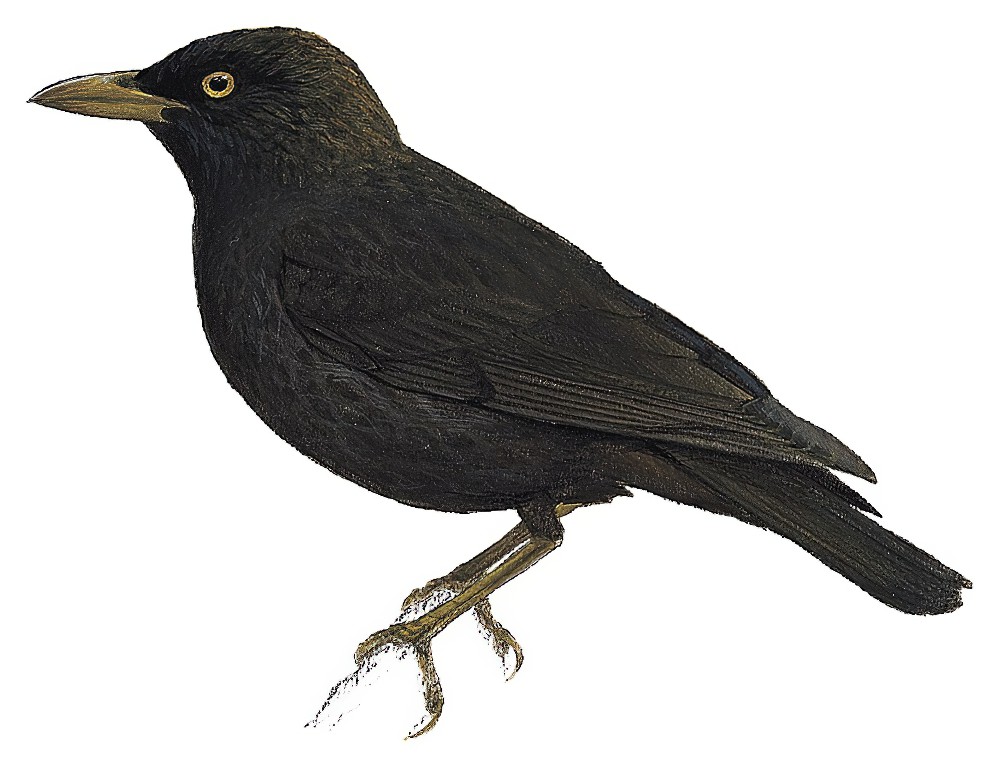Mysterious Starling / Aplonis mavornata

Mysterious Starling
SCI Name:
Protonym: Aplonis mavornata BirdsN.Z.ed.2 ed.2, 1 p.25
Taxonomy: Passeriformes / Sturnidae / Aplonis
Taxonomy Code: myssta1
Type Locality: No locality = ? Raiatea.
Author: Buller
Publish Year: 1887
IUCN Status: Extinct
DEFINITIONS
APLONIS
(Sturnidae; Ϯ Norfolk Starling A. fusca) Gr. ἁπλοος haploos simple, plain; ορνις ornis, ορνιθος ornithos bird; “AT a meeting at the Society's Rooms, Leicester Square, Mr. Gould, after making some remarks on various birds which were on the table, entered into a description of a new genus of birds, for which he proposed the name of Aplornis, on account of its simple structure. This genus, Mr. Gould observed, partakes of the characters of the genera Lamprotornis, Lanius, and Turdus; we will, however, endeavour to give an idea of of its distinguishing characters by comparing it with with the genus Lamprotornis. When thus compared, Mr. G. remarked that the species of Aplornis are altogether of a more robust form: the beak, which is distinctly notched, the wings, the legs, and the tail, are shorter in proportion; the latter is slightly forked. It may also be distinguished by the want of the splendid colouring so remarkable in Lamprotornis, all the species of which, it will be remembered, are of a beautiful rich green colour, with a satin-like gloss. There were two species of this new genus on the table, both belonging to the society; one from New Holland, and the other from the Friendly Islands.” (Gould, 1836, The Analyst, XVII, p. 152); "Mr. Gould exhibited specimens of two new species of Birds from the Friendly Islands and New Holland, of which he proposed to form a genus. He stated them to approximate, in his opinion, in nearly an equal degree to the genera Lanius, Turdus, and Lamprotornis; but believed that they might with propriety be arranged among the Thrushes. Their characters were given as follows: APLONIS. ... In both species the feathers of the head are lanceolate; and the general plumage above has a slight glossy hue, especially on the head and back of the neck" (Gould, 1836, Proc. Zool. Soc. London, IV, p. 73); "APLONIS ... According to Mathews (Ibis, 1942, p. 342) this name, spelled Aplornis, was first proposed in the "Analyst" for Oct. 1, 1836 [not seen], by an anonymous reviewer of Gould's forthcoming description. Even if this citation must stand, the spelling Aplonis may be retained on the ground that Aplornis was a slip of the pen for Aplonis. Gould used the latter spelling in all his publications. He treated the genus as feminine and I have followed this usage." (Amadon in Peters 1962, XV, 75); "APLONIS Gould, 1836 F — Aplonis fusca Gould, 1836; type by subsequent designation (G. R. Gray, 1840, A List of the Genera of Birds, p. 40)." (Dickinson & Christidis (eds.), H. & M. Complete Checklist, 4th ed., 2014, 2 (Passerines), p. 581). Bruce & McAllan 1990, state that Gould’s description of Aplornis in The Analyst was published about two weeks before his description of Aplonis in the Proceedings (see above). They recommend the use of Aplornis (“has been used at least three times in the last 50 years”), but, following Schodde et al. 2007, and by reason of recent majority usage (e.g., Mayr 1941, Baker 1951, Ripley 1961, Mayr & Greenway (ed.) 1962, Rand & Gilliard 1967, Ali & Ripley 1972, Schodde 1975, White & Bruce 1986, Sibley & Monroe 1990, Christidis & Boles 1994, Feare & Craig 1998, Mayr & Diamond, 2001, Dickinson (ed.) 2003, Higgins et al. (eds.) 2006b, Dickinson & Christidis (eds.) 2014, Winkler et al. 2015, Beehler & Pratt 2016, del Hoyo & Collar 2016, Thibault & Cibois 2017), in the interests of stability it is better to retain Aplonis (contra Christidis & Boles 2008). It is astonishing that such a simple name, of obvious etymons, should have caused this turmoil in the rarefied world of nomenclature. Beehler & Pratt 2016 state that the generic spelling Aplonis is now conserved (ICZN Opinion 2285).
Var. Aplornis.
Synon. Calornis, Kittlitzia, Lamprocorax, Macruropsar, Metallopsar, Psaroides, Rhinopsar, Santaplonis, Sturnoides.
mavornata
Misspelling from L. inornata plain; “The specimen is very old, and remained for many years unnoticed in the collection of mounted birds ...agrees fairly well with Forster’s drawing of Turdus badius, and may therefore be Turdus ulietensis of Gmelin ...the name of inornata ...was on the stand of the specimen” (Sharpe 1890). “This species is based on a single specimen of unknown origin that was long overlooked in the collection of mounted birds in the British Museum ....The name is attributed to Buller (1887: 25), who mentioned it ...in an account of Aplonis caledonicus (= Aplonis striata) ...It is quite clear that Buller never intended to describe this specimen as a new species. Furthermore, as indicated by Sharpe (1890), the label on the stand actually said “inornata,” and so the spelling in Buller must have been unintentional, as the specimen was not marked “Aplonis mavornata” ...Although the name is obviously misspelt, Buller’s publication gives no internal evidence of this, as would be required to emend it. Thus, according to the present rules of nomenclature, I suppose the name Aplonis mavornata can stand, although the circumstances of its introduction make me most reluctant to accept it” (Olson 1986). This extinct species, originally thought to have been collected in the Society Islands during Cook’s second voyage 1772-1775, was shown by Olson 1986, to have been secured by Andrew Bloxham on the island of Mauke in the southern Cook group in 1825 (‡Aplonis).
UPPERCASE: current genus
Uppercase first letter: generic synonym
● and ● See: generic homonyms
lowercase: species and subspecies
●: early names, variants, mispellings
‡: extinct
†: type species
Gr.: ancient Greek
L.: Latin
<: derived from
syn: synonym of
/: separates historical and modern geographic names
ex: based on
TL: type locality
OD: original diagnosis (genus) or original description (species)












